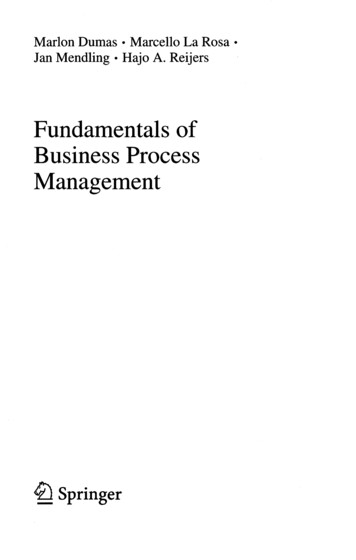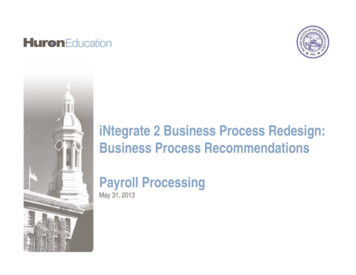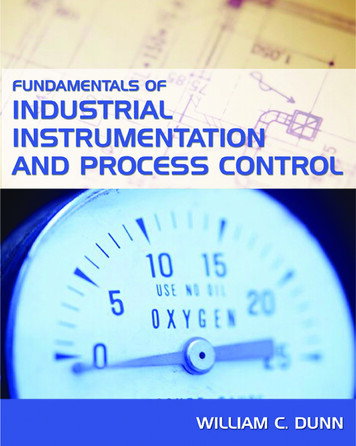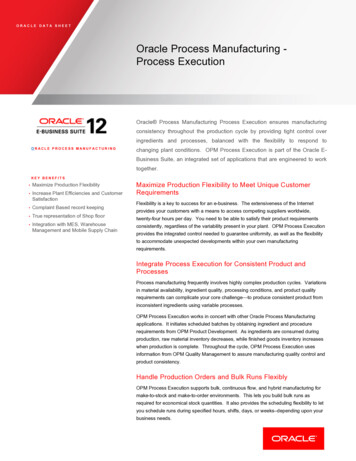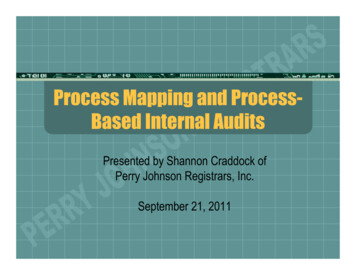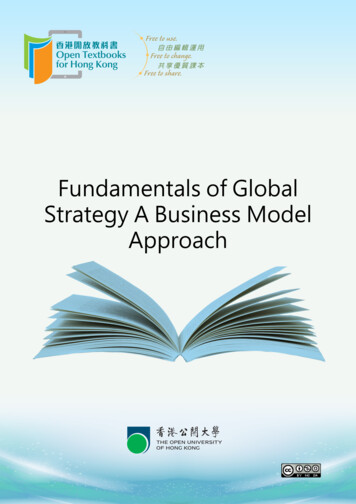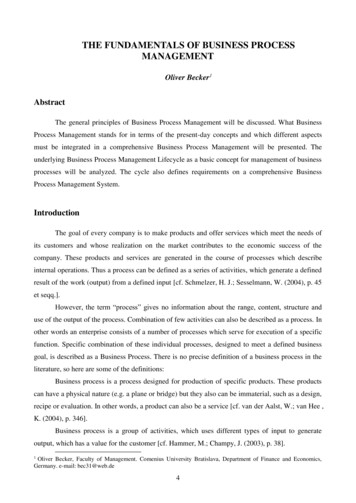
Transcription
THE FUNDAMENTALS OF BUSINESS PROCESSMANAGEMENTOliver Becker1AbstractThe general principles of Business Process Management will be discussed. What BusinessProcess Management stands for in terms of the present-day concepts and which different aspectsmust be integrated in a comprehensive Business Process Management will be presented. Theunderlying Business Process Management Lifecycle as a basic concept for management of businessprocesses will be analyzed. The cycle also defines requirements on a comprehensive BusinessProcess Management System.IntroductionThe goal of every company is to make products and offer services which meet the needs ofits customers and whose realization on the market contributes to the economic success of thecompany. These products and services are generated in the course of processes which describeinternal operations. Thus a process can be defined as a series of activities, which generate a definedresult of the work (output) from a defined input [cf. Schmelzer, H. J.; Sesselmann, W. (2004), p. 45et seqq.].However, the term “process” gives no information about the range, content, structure anduse of the output of the process. Combination of few activities can also be described as a process. Inother words an enterprise consists of a number of processes which serve for execution of a specificfunction. Specific combination of these individual processes, designed to meet a defined businessgoal, is described as a Business Process. There is no precise definition of a business process in theliterature, so here are some of the definitions:Business process is a process designed for production of specific products. These productscan have a physical nature (e.g. a plane or bridge) but they also can be immaterial, such as a design,recipe or evaluation. In other words, a product can also be a service [cf. van der Aalst, W.; van Hee ,K. (2004), p. 346].Business process is a group of activities, which uses different types of input to generateoutput, which has a value for the customer [cf. Hammer, M.; Champy, J. (2003), p. 38].1Oliver Becker, Faculty of Management. Comenius University Bratislava, Department of Finance and Economics,Germany. e-mail: bec31@web.de4
Business process is a structured, measurable number of activities designed to generate aspecific output for a specific customer or market. In this regard there are two approaches: either it isimportant how the work is organized within the enterprise or it is important what is made, if theproduct instead of the business process stands in the forefront [cf. Davenport, T. (1993), p. 5].Business process is a number of interconnected procedures or activities, which fulfill acommon business goal or pursue a common business strategy; usually, this approach is used in thecontext of an organizational structure, in which functional roles and relations are defined [cf. w/oauthor WfMC (1999), p. 10].To understand, what specific parts of a business process stand for and how the abovedefinitions should be interpreted, individual element types of a process will be analyzed in the nextpart.Classification of Business ProcessesAfter the analysis of composition of a business process, the question how processes can beclassified arises.Business processes can be classified according to various criteria. One of the possibilities isto structure them according to their complexity and frequency. In this regard, figure 1 shows areasonable classification:Source: Gadatsch, A. (2003), p.30Fig. 1: Differentiation of Business Processes5
Classification takes into account the frequency and structurability (x-axis) on the one handand complexity (y-axis) on the other. According to these criteria, business processes can beclassified into the four categories described below: [cf. Gadatsch, A. (2003), p. 30]:1. One-time case for experts – this type of process represents a unique process whichdoes not repeat and which is in general given to hands of experts.2. One-time case for staff workers – this includes unexpected problems or interferencefrom the outside. This process also represents a one-time event, but this time it is anevent which is in general manageable by accountable workers without specificknow-how.3. Regular case for experts – this is a recurrent process which must be handled byexperts with specific know-how.4. Routine case with strong support of the system – this type is characterized by a highfrequency of the process and its low complexity. Tasks which must be fulfilled insuch process can be handled by ordinary staff workers.The above-mentioned categories indicate how complex the business process is. Afterwardsit can be assumed whether the process can be (partially) automated.Business processes can also be differentiated according to their relation to core business2 ofcompanies. In this regard it can be distinguish between core processes and supporting processes.Core processes represent essential processes which are directly engaged in the productionprocess and which hence require specific know-how [cf. Bullinger, H.-J.; Schreiner, P. (Publ.)(2001), p. 40 et seqq.]. These processes are in general crucial for success in the competition as theirresults form the essential part of the value offered to the customer. They represent core qualities ofthe enterprise which can use them to distinguish from its competitors. These processes indicate theposition of companies and decide about their economic success or failure.Supporting processes serve as a basis for operational business activities and provideresources for core processes [cf. Bullinger, H.-J.; Schreiner, P. (Publ.) (2001), p. 43]. They do notenter directly into the value offered to the customer and are not crucial for success in thecompetition.Business Process ManagementSo far, companies have concentrated either on modeling and communication of theirbusiness processes or on integration of applications at a data or system level [cf. Krameyer C.2The core business describes the main activities which are direct linked with the creation of products or services in thescope of the company. It includes the core competences, core products and end products.6
(2004)]. However, business demands have now become much more important. Companies mustmake their production more profitable and at the same time increase their productivity. They alsomust achieve higher loyalty of their customers which requires closer cooperation with their externalbusiness partners. This leads to highly integrated business processes, which should also be flexibleand capable of respond to short-term changes. The figure 2 below shows an example of suchintegrated process.Therefore, business processes must be managed. In other words, there must be controlledintegration of the business process and IT systems. This is the first prerequisite for implementationof Business Process Management.Fig. 2: Example of the Integrated Business ProcessBusiness Process Management (BPM) stands for an integrated concept of management,organization and controlling, which enables strategic direction of business processes and heads thecompany towards satisfaction of customers needs as well as needs of other interest groups(employees, creditors, owners, suppliers, partners) [cf. Schmelzer, H. J.; Sesselmann, W. (2004), p.5].To date there is no uniform definition of Business Process Management. In the literature it isdescribed as a continuous process which includes definition, modeling, implementation, control andmonitoring of business processes.Business Process Management hence encompasses all measures for planning, organizationand inspection as a basis for strategic management and control of processes. Processes areexamined, controlled and improved in BPM (compare also figure 3). Thus process managementanalyzes core- as well as supporting processes, so that redundant processes and process stages canbe eliminated. Core processes which contribute to generation of the value are put to regular tests of7
effectiveness and efficiency because requirements on processes are subject to a permanent change.The objective of process management is therefore to standardize processes in order to make themreproducible. This makes processes more economic which leads to increased effectiveness andefficiency and in the end also to higher benefits from customers [cf. Schmiemann, M. (2004), p. 15].Source: Schmelzer, H. J.; Sesselmann, W. (2004), p.5Fig. 3: Objectives, Functions and Components of BPMThe number of stages in which process management should be realized may differ. In thenext part 5 stages will be introduced, in which process management should take place [cf.Schmiemann, M. (2004), p. 17 et seq.]:Stage 1:At first a person accountable for the process and process master should be appointed. Theprocess master assumes responsibility for the process either on a basis of his position in theorganizational structure or this task is simply assigned to him. His job is to define, measure andmanage the process as well as push through his continuous improvement. He must understandactivities in the process and act as a middleman between the supplier and customer. He can providerequired resources and exert influence over the process. He is responsible for execution of the next4 stages.Stage 2:Description of the process – description of the process requires documentation of thecustomer’s demands and demands on the supplier as well as description of partial processes. Itsadvantage lies in clear specification of customer-supplier relations, engagement of all theparticipants and clear specification of responsibilities. But it also enables clear definition ofactivities, so that problems can be recognized in time. It leaves the potential for improvements openand makes the overall process transparent.8
Stage 3:Measurement of the process – to find out whether the process meets the definedrequirements, relevant measurements must be made. It can be verified whether the input satisfiesthe requirements on the process and whether the output is up to demands of the customer. It canalso be examined whether inside the process the requirements are met. The main objective is tohave all information collected to get an suitable statement about the effectiveness and efficiency ofthe process.Stage 4:Mastering the process – the process is mastered at the moment when all the requirements aresatisfied while at the same time quality of measurement criteria are preserved. It means thatcustomers are satisfied, all the activities take place as defined in the description, warnings are issuedprior to significant mistakes if there are discrepancies and improvements are made either asprecautionary measures or remedies to defective products and services which do not measure up tostandards. It is also important to find the roots of the problem to prevent the same mistakes in thefuture.Stage 5:Improvement of processes – the last step is then the improvement of the process throughpermanent advancement of its quality. In this stage the process master should create conditions inwhich no mistakes are made in course of the process. Reduction in the rate of defectiveness not onlyincreases the quality of offered products and services but also cuts costs that would have to beotherwise incurred for elimination of defects. To reach this objective the last step will be a recurringstep because it is one continues procedure to improve the quality.To meet the above-mentioned requirements on Business Process Management, it is essentialto make arrangements for process modeling, workflow management, Enterprise ApplicationIntegration (EAI) as well as process monitoring.Process ModelingModeling is a procedure for construction of a model. There are two roles to be distinguishedin a process of modeling: knowledge holder, who has specific know-how about the process andmodeler, who is responsible for production of the model. Both roles can be embodied in one person.The modeler discusses objectives with the knowledge holder and collects all information requiredfor modeling. This data is then structured and described with a help of suitable methods. Theknowledge holder must in the end check whether the produced model is consistent. This procedure9
can repeat several times if the model does not meet expectations of the knowledge holder [cf.Richter-von Hagen, C.; Stucky, W. (2004), p. 59 et seq.].A process model is an important instrument for communication of process ideas toemployees and managers. It is an abstract, simplified picture of a real process with all relevantfunctions and aspects. It shows all essential interrelations of the process in a simple constructionand hence demonstrates development of individual partial processes [cf. Schmelzer, H. J.;Sesselmann, W. (2004), p. 157et seq.].Functions and Objectives of Process ModelingProcess modeling demonstrates essential functions of a process in an abstract model. Itenables the reduction of the complexity of real processes so that processes in a model become moretransparent. A process model can hence be used as an information- and communication instrumentfor all parties taking part in the process. Process modeling is a basis for retrieval of information forcontrolling and quality management. Process models help systematize processes in a structurewhich shows system defects, interrelations and personal responsibilities. Process modeling makesthe process transparent for all the participants, which in result facilitates communication because theprocess and its structure are clearly and uniformly described.Process modeling also helps document knowledge of individual workers so that thisknowledge is available for all other participants in the process3. This is especially useful for anewcomer who must familiarize himself/herself with his/her new job – not only because knowledgeof their colleagues is documented, but also because they get to know where specific information arestored and learn to find their position i
THE FUNDAMENTALS OF BUSINESS PROCESS MANAGEMENT Oliver Becker1 Abstract The general principles of Business Process Management will be discussed. What Business Process Management stands for in terms of the present-day concepts and which different aspects must be integrated in a comprehensive Business Process Management will be presented. The underlying Business Process
